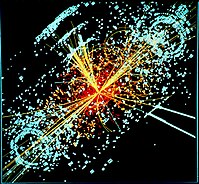
Photo from wikipedia
Abstract This work is a continuation of our recent study of non-relativistic charged particles, confined to a sphere enclosing a magnetic dipole at its center [1]. In this sequel, we… Click to show full abstract
Abstract This work is a continuation of our recent study of non-relativistic charged particles, confined to a sphere enclosing a magnetic dipole at its center [1]. In this sequel, we extend our computations in two significant ways. The first is to a relativistic spin-$$ \frac{1}{2} $$ 1 2 fermion and the second concerns the interpretation of the physics. Whereas in [1] we speculated on the possibility of observing such condensed matter systems in the astrophysics of extreme magnetic sources such as neutron stars, the physical systems in this study are more down-to-earth objects such as a C60 fullerine enclosing a current loop. We unpack some of the details of our previous analysis for the spinless fermion on the dipole sphere and adapt it to solve the eigenvalue problem for the single-particle Dirac Hamiltonian. In the strong-field/small-radius limit, the spectrum of the spin-$$ \frac{1}{2} $$ 1 2 Hamiltonian, like the spinless case, exhibits a Landau level structure in the |m| ≪ Q regime. It features a new, additional (approximately) zero-energy lowest Landau level which persists into the |m| < Q regime. As in the spinless system, the spectrum exhibits level-crossing as the strength of the magnetic field increases, with the wavefunctions localising at the poles in the strong-field/small-radius limit.
Journal Title: Journal of High Energy Physics
Year Published: 2021
Link to full text (if available)
Share on Social Media: Sign Up to like & get
recommendations!